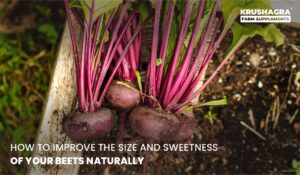A thin line exists in both these sustainable options of impregnetions. Know how.
We are not new to using a term casually enough that the original meaning of it is lost in our daily conversations. Sometimes, it is because the differences that are not clearly visible or because of poor understanding of a concept. This write-up is an attempt to understand the thin line between biofertilizers and organic fertilizers since both terms are used loosely and interchangeably most of the time. They have differences in terms of characteristics, application, types, and functioning. Let’s dive into the brief details of their distinguishing attributes.
Characteristics of Biofertilizer and Organic fertilizer
Biofertilizer – It is a product containing carrier-based (solid or liquid) living microorganisms that are agriculturally useful in terms of nitrogen fixation, phosphorus solubilization, or nutrient mobilization, to increase the productivity of the soil and/or crop. It embodies live bio-mass or dormant cells of effective microbial strains.
Examples of biofertilizers include Rhizobium, Azotobactor, Azospirillium, etc. These are categorized into 4 divisions – Bacterial, fungal, algal, and actinomycetes.
Organic fertilizer – It is a substance made up of one or more unprocessed material(s) of a biological nature (plant/ animal) and may include unprocessed mineral materials that have been altered through the microbiological decomposition process. It is also called organic manure.
Organic fertilizers comprise sewage, cattle waste, dry leaves, crop residue, twigs, meat meal, and agro-based industrial wastes like mushroom compost, bagasse, and alike dry or liquid forms of manure. These natural substances are broadly categorized into 3 types – farmyard manure, green manure, and compost manure.
Biofertilizers contain specific microbes with measurable cells whereas organic fertilizer does not have a specified cell number.
Application of Organic fertilizer
Organic fertilizer is applied directly to the soil and biofertilizers can be fed to the soil, seeds, and crop surfaces. Usually it is spread uniformly across the farm, two or more weeks before being incorporated into the soil during land preparation.
Broadcasting is the most common technique of implementing solid, slurry and liquid type of organic fertilizers to the crops. Other forms include brand spread, trailing hose, trailing shoe, and deep or shallow injection of organic fertilizer below the soil surface.
These are largely used for vegetables, fruits, and cash crops.
Application of Biofertilizer
Biofertilizers are available in liquid or solid-based formations and are put in seedlings, seeds, and the soil in an indirect manner. These microbial inoculants occupy the rhizosphere of the soil or the plant interior and provide essential nutrients to the plants. It can be applied through seed treatment, soil treatment, or drip irrigation methods.
One should be aware of the types of biofertilizers available in the market and where they are required. Specific fertilizers are used for specific crops. This goes for symbiotic micro-organisms specifically. For example, If a non-specific Rhizobium is used as fertiliser, then it will not lead to root nodulation and increase in crop production. Plus you should ensure right combination of biofertilizer and use it before expiry.
Benefits and limitations of Organic fertilizer
Organic manure has less concentration of nutrients. The quantity of potassium, phosphorous, and nitrogen is low. It is an eco-friendly substitute for chemical fertilizer but the most common drawback of these products is that it takes time to affect the plant growth as compared to chemical fertilizer.
Moreover, producing manure on your own is possible but is an extremely time-consuming and complicated process. Making manure, applying it to the soil, and waiting for the results is a slow procedure and hence it is recommended mostly to have a small-scale production line of this fertilizer.
Even though it can be produced by farmers on their own, it is required in enormous amounts to supply enough nutrients. Plus the storage of manure could be difficult. All these factors contribute to increasing the charges and make this option more expensive when not utilized and stored aptly.
Eventually, maintenance and storage of organic fertilizers decides its shelf life. If preserved rightly in a dry and cold place, the manure can sustain for about 5 years in an effective state. After that, its efficaciousness decreases.
Benefits and limitations of Biofertilizer
Biofertilizers are easy to apply. But being a live product, they require care in the storage. They are considered to be cost-effective, especially for low-income farmers. In addition to that, the manufacturing of biofertilizers can be performed as a by-product of electricity generation from bio-gas.
Since its crop specific, what works for one crop, won’t necessarily go for another.
It helps in combating the severe effects of drought and other harmful weather conditions.
The shelf-life of a solid carrier-based biofertilizer is around 6 months; however, it could extend to 2 years for a liquid formulation biofertilizer.
Conclusion :
Both organic manure and biofertilizer are the best substitutes for chemical fertilizers considering the environmental concern. They are non-toxic to humans, animals, and other organisms. Combining biofertilizer with organic manure can result in better enhancement in crops and promote plant growth without any soil degradation and penetration of chemicals on the land. It can accelerate the root biomass. Many small scale farmers prefer utilizing organic manure for small scale farms, especially when they are into diary or goat farming simultaneously. On the other hand, a report suggests the demand of biofertilizers is increasing with rising awareness regarding its benefits and environmental harms of chemical fertilizers.
Krushagra’s range of biofertilizers serves the market demand and caters to all kinds of crops produced in India.They are available in affordable rates and accessible to farmers who look forward to implement organic farming.






